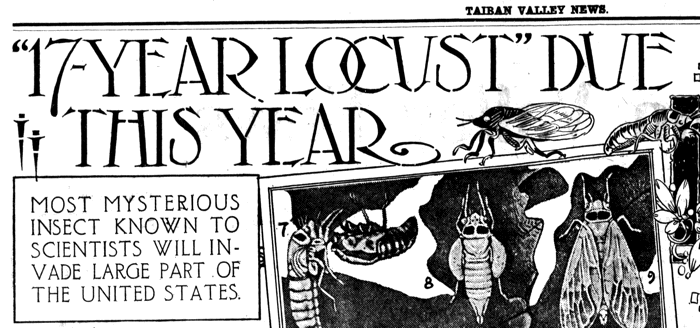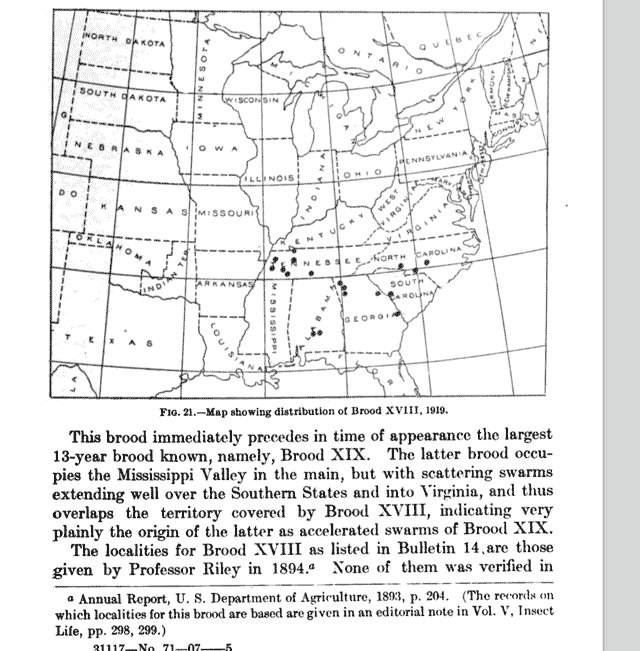
I was looking through old newspapers for articles about periodical cicadas. I found an article in the Taiban Valley News from April of 1919, titled “17-Year Locust” Due This Year1. The Taiban Valley news was published out of New Mexico, which does not experience periodical cicadas aka “17-year locusts”, so I guess the story was supplied to its readers as a curiosity — just something oddball/interesting to read. The text of the article was supplied by the U.S. Department of Agriculture (possibly C.L. Marlatt himself), and the main image of the article is an illustration that appeared previously in U.S. Department of Agriculture documents and is attributable to a Miss L. Sullivan2.
“Locusts”
97 years ago people called periodical cicadas “locusts”, just as they do today. I quote, “It has been so long miscalled by the name of locust, however, that there is no hope of divesting it of that incorrect appellation”. “No hope”! Even today, about half the people I meet call them “locusts”.
Human lifespans were a lot shorter 97 years ago
The next fact — and this startled me — is how short the average human lifespan was 97 years ago. I quote: “The fact that it appears in countless numbers one year, then is not seen again for half the average lifetime of human beings and then suddenly appears again in countless numbers”.
Half the average lifespan of human beings? Back in 1919 the average life expectancy was just 55. At most a person could expect to witness 3 emergences back then, and since babies and toddlers really don’t remember things, 2 times makes sense. Today (2016) life expectancy is around 79 years in the U.S., which means the average person will only get to see 4. I’ve seen 9, but I travel around.
Vermont still had periodical cicadas:
Back in 1919, Vermont still had periodical cicadas: “with some Isolated colonies as far northeast as upper Vermont”. Since then, they must have gone extinct.
Brood 18?
The article talks about Brood 18 emerging in the same year as Brood 10 (note, the article does not use Roman numerals). I believe the Brood 18 the article they refer to is what we now call Brood 19 (XIX) today. The article describes Brood 18 as having a 13-year life cycle, and occurring in Alabama, Georgia, North Carolina, South Carolina and Tennessee. The only brood that matches that is Brood XIX (see the map).
If it is indeed Brood XIX, the article is likely incorrect about the coincidence of Brood XIX and X emerging in 1919. While Brood X definitely emerged in 1919, Brood XIX would emerge in the following year 2020. Interestingly enough, the now extinct Brood XI emerged in 2020 (in Connecticut).
The rest of the article is less remarkable, but still a fun read for “the most interesting insect in the world”.
Update (8/26/2016):
David Marshall of the University of Connecticut pointed out a map of the Brood XVIII that was indeed set for emergence in 1919, which is likely what the writes of the article were citing. David points out though that this Brood XVIII was likely comprised of one-year-early emergences (stragglers) of Brood XIX, rather than an actual unique brood.

1 Taiban Valley news., Taiban, Roosevelt County, N.M. April 04, 1919.
2 C. L. MARLATT. Account Of Cicada Septendecim, Its Natural Enemies And The Means Of Preventing Its Injury, Together With A Summary Of The Distribution Of The Different Broods. U. S. Department Of Agriculture. Division Of Entomology. Bulletin No. 14. 1898.

Leave a Reply